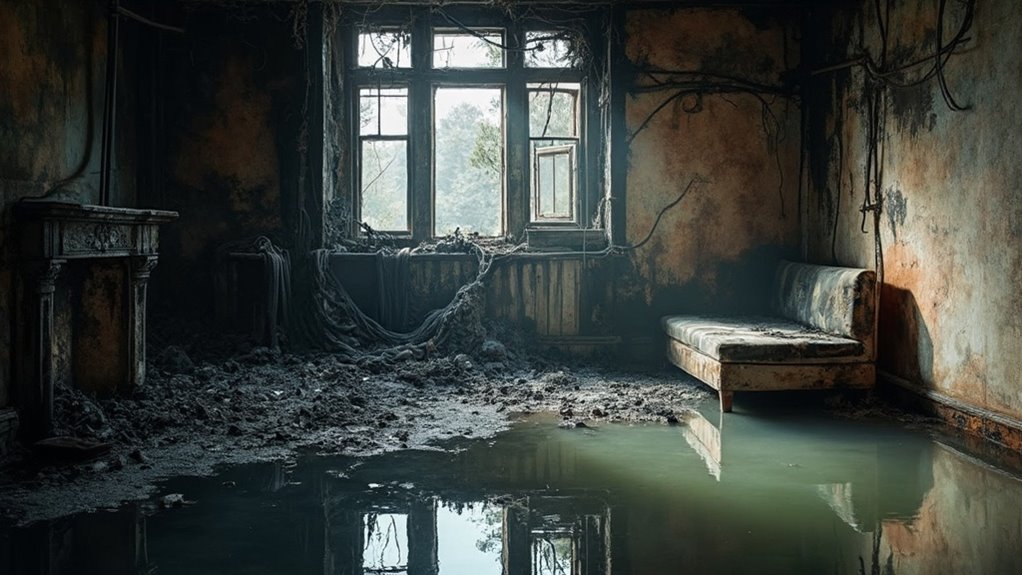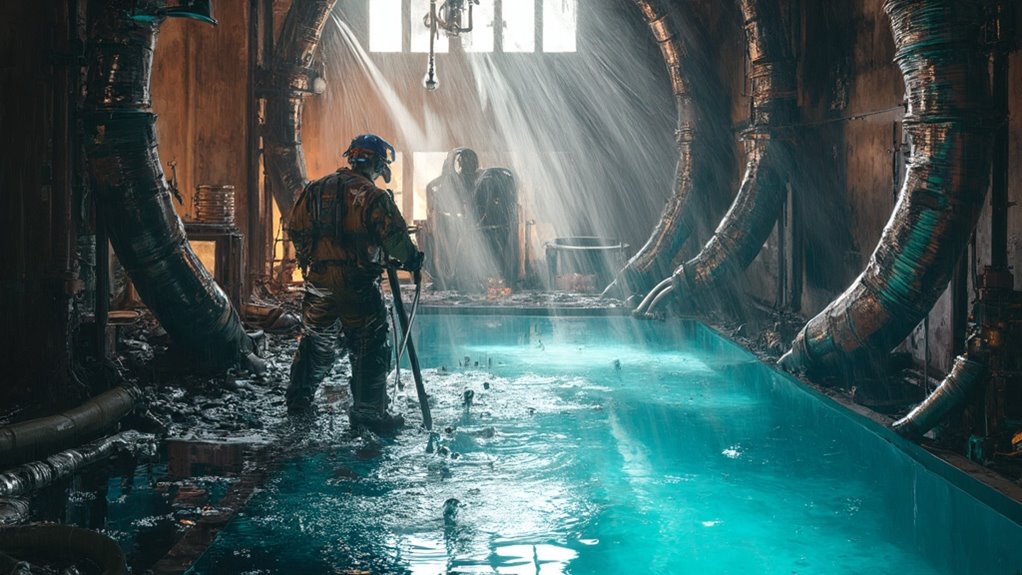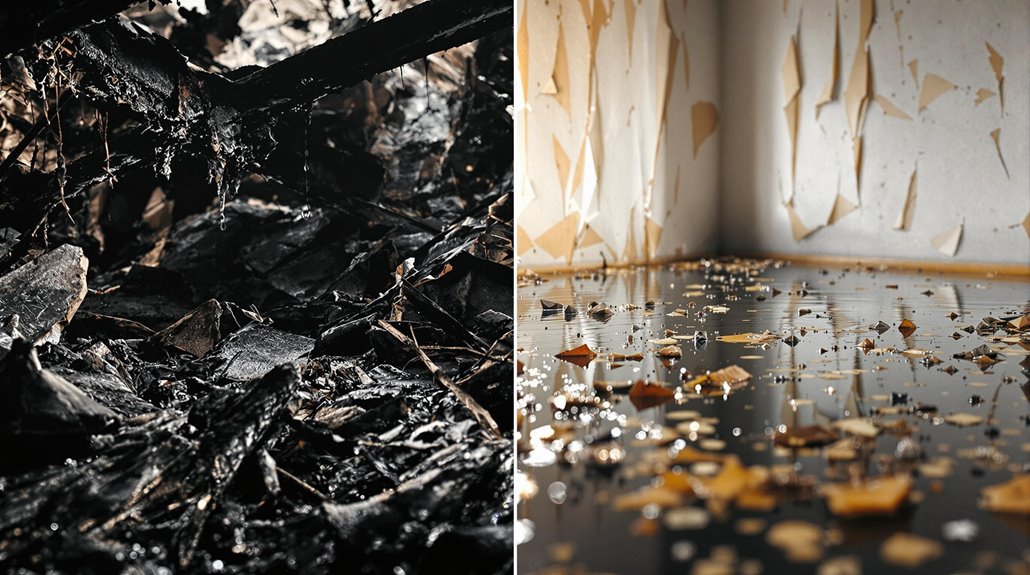When facing damage from fire or flooding, you're not alone. Expert solutions from Care Pro Restoration guarantee your property is restored efficiently. They start by evaluating the extent of damage, followed by precise water extraction and drying techniques to prevent mold growth. Their empathetic team guides you through each step while assisting with insurance claims, making the process less intimidating. By examining vulnerabilities and implementing preventative measures, they improve your property's resilience against future incidents. You'll find that understanding these thorough restoration services is key to your recovery journey. More insights await you on your path to restoration.
Key Takeaways
- Care Pro Restoration provides expert assessment and quick response for both fire and flood damage restoration needs.
- Their comprehensive restoration process includes water extraction, drying, and smoke residue removal to ensure thorough recovery.
- Preventative measures and resilience strategies are implemented to mitigate future risks of water and fire damage.
- Care Pro assists clients in navigating complex insurance claims, ensuring timely reporting and organized documentation for successful outcomes.
- They offer clear communication throughout the restoration process, keeping homeowners informed and confident in their recovery journey.
Understanding Water Damage

Understanding water damage is significant for homeowners looking to protect their property and maintain a safe living environment. Water leakages often stem from deteriorating pipes, which can develop cracks or holes over time, leading to unnoticed leaks that can wreak havoc on your walls, floors, and ceilings. Regular pipe inspections are important; addressing leaks promptly can save you from costly repairs and health risks associated with mold and rot. Additionally, regular inspections can help identify potential pipe issues before they escalate into major problems. Immediate action is crucial as it can prevent further damage and health risks associated with prolonged exposure to moisture.
Roof leaks are another common culprit, often caused by missing shingles or clogged gutters. Water can seep into your home, damaging not only the roof but likewise the foundation. To prevent this, confirm your gutters are clean and direct water away from your property.
Furthermore, malfunctioning appliances and sewer backups can lead to significant water damage. Regularly inspecting appliances and maintaining sewer systems are critical practices. Natural disasters can further worsen water issues, making it imperative to evaluate your home's vulnerability.
Fire Damage Restoration Process
When a fire devastates your property, the road to recovery begins with a structured restoration process that prioritizes safety and efficiency. The initial steps focus on a thorough fire assessment, guaranteeing no detail is overlooked. Here's what you can expect:
- Emergency Contact: Call restoration specialists to report the incident and gather critical details.
- Inspection and Damage Assessment: Specialists evaluate fire and smoke damage, creating a tailored plan for restoration.
- Cleanup and Drying: This includes the removal of smoke damage and complete drying processes.
Once the damage is assessed, securing your property is paramount. This involves board-ups, debris removal, and structural reinforcement to prevent further harm. After confirming safety, the cleanup phase focuses on removing smoke residues and sanitizing affected areas. Additionally, professionals utilize advanced techniques for smoke and soot removal to ensure thorough cleaning.
Restoration and reconstruction follow, addressing both minor and major repairs, and replacing damaged systems. Finally, a meticulous final inspection guarantees everything meets the required standards for safety and habitability. By understanding this process, you can navigate the complexities of fire damage restoration with confidence, knowing that each step is designed to restore your property effectively.
Water Extraction Techniques

After addressing fire damage and restoring safety to your property, the next critical step is effectively handling water intrusion. To initiate successful water recovery, you must first identify and stop the source of the water. Utilize moisture sensors and meters to assess the extent of moisture content in affected areas like floors, ceilings, and walls. It's vital to halt any ongoing damage by stopping the water source if possible, particularly if the water is contaminated.
Safety concerns should remain a priority; turn off power supplies, wear protective gear, and check for hazards such as compromised electrical sockets. Once safety is guaranteed, focus on water extraction techniques appropriate for the situation. For significant flooding, submersible pumps work efficiently to remove standing water, while trash pumps handle debris-laden water. For smaller-scale needs, industrial-strength wet/dry vacuums can be employed effectively.
Incorporating specialized equipment improves moisture management; infrared cameras can detect hidden moisture pockets, and high-capacity pumps expedite the extraction process. By employing these water extraction techniques, you can mitigate damage and lay the groundwork for thorough restoration.
Drying and Dehumidification Methods
Effective drying and dehumidification are critical steps in restoring a property after water damage. To achieve ideal results, you need to employ a combination of natural airflow and mechanical methods. Here's how you can improve the drying process:
- Open all windows and doors to promote natural airflow, especially when humidity is moderate.
- Utilize high-powered mechanical fans, like axial and centrifugal blower fans, to boost air circulation.
- Combine air movers with dehumidifiers for maximum effectiveness.
Natural airflow is your first line of defense. Guarantee air circulation to all areas by opening cabinet and closet doors, which helps speed up the drying process in well-ventilated spaces. Once you've established this, mechanical fans come into play. Unlike ceiling or box fans, specialized air movers are designed to cover large areas quickly and should operate continuously for 24-48 hours.
Dehumidifiers are similarly important. They extract water vapor from the air, preventing mold growth and guaranteeing even drying. By strategically combining these methods, you can achieve a thorough drying process and safeguard your property from further damage. Mastering these techniques is significant for effective water damage restoration.
Preventing Future Damage

Restoring a property after water damage is only part of the solution; preventing future incidents is just as vital. To protect your home, start by evaluating and addressing structural vulnerabilities. Identify weak points, like cracks in the foundation or gaps around windows, and seal them to prevent water seepage. Regularly inspect and replace deteriorating caulking to maintain a watertight barrier.
Elevating vital utilities is important. Place electrical panels, heating systems, and water heaters at least 12 inches above the Base Flood Elevation to reduce risk. Furthermore, installing flood barriers and flood vents will allow water to flow through while safeguarding your property.
Effective drainage and water management are likewise key. Verify your drainage systems redirect water away from your home—clear gutters and consider installing French drains or sump pumps. Modify your landscaping to improve drainage and use rain barrels to collect excess water.
Finally, invest in preventative technologies, such as smart flood sensors and water leak detectors. Create an emergency plan with your family to guarantee preparedness. By implementing these strategies, you'll markedly reduce the risk of future water damage and bolster your home's resilience.
Comprehensive Restoration Services
Understanding the complexities of property damage can be overwhelming, but detailed restoration services are designed to address every aspect of recovery. With Care Pro Restoration, you can expect a meticulous approach that combines advanced restoration technology and expert knowledge.
Here are key components of our extensive restoration services:
- Emergency Response and Assessment: Immediate action to minimize damage through a detailed property assessment.
- Water and Flood Damage Restoration: Efficient water extraction and dehumidification to prevent long-term issues.
- Fire and Smoke Damage Restoration: Specialized techniques to eliminate soot and odors, ensuring a safe environment.
Each step is critical to restoring your property to its pre-damaged state. Our team conducts a thorough evaluation to develop a tailored restoration plan, ensuring all systems are functional and safe. By leveraging state-of-the-art restoration technology, we not only repair but also improve your property's resilience to future incidents. You deserve a restoration process that prioritizes your needs while delivering exceptional results. Let us guide you through this challenging time, providing the expertise and empathy required for a successful recovery.
Insurance Claim Support

Maneuvering through the insurance claims process after property damage can feel intimidating, but you don't have to face it alone. Understanding the insurance requirements is essential for a successful claim. Start by promptly contacting your insurance company to report the damage. Gather necessary documentation, including photos or videos, and make sure you have your policy number handy. This initial step can greatly impact your claim process.
Once you report the damage, an insurance adjuster will assess it. They'll document repairs needed, so it's important to separate damaged items and create a thorough list. Organizing your documentation will assist their review.
Next, obtaining estimates from approved restoration companies is vital. These estimates help establish the scope and cost of repairs, which the insurance company must approve. Make certain any agreements clearly state that work will only proceed upon claim approval.
Finally, after approval, the insurer will provide funds to either you or the restoration company. Throughout this process, maintain open communication with your restoration team, making sure you stay updated on project execution. By mastering these steps, you'll navigate the claims process with confidence and clarity.
Conclusion
As you navigate the aftermath of disaster, remember that every moment counts in the restoration process. With expert solutions at your fingertips, the path from fire to flood can transform into a journey of recovery and renewal. Don't let uncertainty linger; take action now to prevent further damage. With thorough support and strategic planning, you can reclaim your space and peace of mind. The next chapter of your home awaits—are you ready to turn the page?




